12 November 2006
An Ironic Twist Of Fate
Even the most liberal of Republicans were unceremoniously tossed from office as the mid-term elections became a referendum on the Iraq War and the performance of the President. US Senator Lincoln Chaffee, a Republican so liberal that voted against Bush's agenda approximately 90% of time, was tossed out on his keester. Republicans across the country were swept from office in a domino effect from the Federal level down to the state and local levels.
As a Democrat, I should be doing cartwheels right now. To a certain extent I am. This election essentially offers a check on the right wing agenda. Bush's reactionary judicial candidates no longer have a snow ball's chance in hell of getting confirmed. (However, the damage has already been on the Supreme Court. I'm just hoping that the last of the liberals and centrists can hang on until after the next election). Bolton will be out at the UN and Rumsfeld is history.
But, I'm also concerned. I know that the exit polls tell us that that the new Democratic majority is more a repudiation of Bush's policies as opposed to an affirmation of the Democratic agenda. The Democrats won without having a clear message and plan for moving forward. There is much at stake between now and the next presidential election in 2008. Up for discussion: a long overdue increase in the minimum wage, environmental protection, eroding civil liberties and increased governmental surveillance, health care issues, education, abortion rights, stem cell research, and of course how do we extricate ourselves from the growing quagmire in Iraq?
It's been quite some time since we Democrats had a standard bearer--a leader to motivate the masses and make us vote for something rather than against. The leadership vacuum within the Democratic Party worries me greatly. Nancy Pelosi is poised to become the first female Speaker of the House. But, she's has the potential to be polarizing and is the type of liberal that, unfortunately, doesn't play well in the more conservative heartland. There's Hillary Clinton, who people either love or hate (see Nancy Pelosi's problem). I'm one of the rare ones who can't decide if I like her or not. Barak Obama has generated a lot of attention lately, but, he's untested and I really don't know enough about where he stands on the issues. John Kerry would like another crack at the Presidency, but frankly he's the King of Foot in Mouth Disease lately and he ran a crappy campaign last time. (I voted against Bush rather than for Kerry). Also waiting in the wings are Evan Bayah (who I don't like) and VP candidate John Edwards (from whom I'd like to see more). I'm sure there are a few others, but frankly, the fact that I can't remember who they are should tell you just how much of an impression they've made on me.
We need a leader to step forward that has a vision--a plan. And I fear greatly we don't have it. We've got 2 years to set ourselves up for success in the 2008 election cycle. The Republicans 2 years to regroup. If we muck up this opportunity, the odds of retaking the White House are slim. As much as I'd like to sit back and enjoy watching Bush stymied for two years, we as a party need to give our nation more than 2 years of gridlock. We need a leader who can provide hope and light the way to a brighter future. The question is, "Do we have one?"
09 November 2006
Windmills, Vineyards and French Tragedy
 I spent my last afternoon in Paris, wandering the winding, hilly cobblestone streets of Montmartre. I signed-up for a 2 hour walking tour through Classic Walks Paris. My guide for the afternoon, Connie, dubbed it the "Stair Master Tour" due the multiple trips up, down around the hill crowned by the Sacre Coeur Cathedral. It could also be called the "Tour of Artistic Tragedy". Montmartre was home to famous artists, singers and writers including Van Gogh, Picasso, Toulouse-Lautrec, Pissaro, Renoir, Utrillo, Matisse, Dalida and many others. Our afternoon walk started out in front of the famed Moulin Rouge.
I spent my last afternoon in Paris, wandering the winding, hilly cobblestone streets of Montmartre. I signed-up for a 2 hour walking tour through Classic Walks Paris. My guide for the afternoon, Connie, dubbed it the "Stair Master Tour" due the multiple trips up, down around the hill crowned by the Sacre Coeur Cathedral. It could also be called the "Tour of Artistic Tragedy". Montmartre was home to famous artists, singers and writers including Van Gogh, Picasso, Toulouse-Lautrec, Pissaro, Renoir, Utrillo, Matisse, Dalida and many others. Our afternoon walk started out in front of the famed Moulin Rouge.The reason that the cabaret is topped by a windmill (Moulin) is that Montmartre was dotted with them back in the day. A handful still remain atop the hill.
 After taking in the Moulin Rouge, we walked to the Montmartre Cemetery. The Montmartre Cemetery open roughly around the same time as the Pere LaChaise Cemetery that I had visited the week before. When it opened, the cemetery was on the outskirts of Paris and now, the city has grown around it and in some cases over it.
After taking in the Moulin Rouge, we walked to the Montmartre Cemetery. The Montmartre Cemetery open roughly around the same time as the Pere LaChaise Cemetery that I had visited the week before. When it opened, the cemetery was on the outskirts of Paris and now, the city has grown around it and in some cases over it. While Montmartre has its share of famous citizens (primarily artists, actors and writers who lived in Montmartre including Edgar Degas, Alexandre Dumas, Dalida), it houses many families of the non-famous. Unlike most US cemeteries where you buy a plot and it's yours forever, you only lease plots in most Parisian cemeteries. Your family has to renew the plots on a regular basis, to keep the bodies interred there permanently. If someone fails to renew and pay for the plot, eventually the bodies will be removed and moved to a central grave or crematorium for permanent storage. The plot will then be released to someone else.
While Montmartre has its share of famous citizens (primarily artists, actors and writers who lived in Montmartre including Edgar Degas, Alexandre Dumas, Dalida), it houses many families of the non-famous. Unlike most US cemeteries where you buy a plot and it's yours forever, you only lease plots in most Parisian cemeteries. Your family has to renew the plots on a regular basis, to keep the bodies interred there permanently. If someone fails to renew and pay for the plot, eventually the bodies will be removed and moved to a central grave or crematorium for permanent storage. The plot will then be released to someone else. 
 One of the most famous recent denizens buried in the Montmartre cemetery, is Dalida, a legendary French singer that committed suicide in 1987 at the age of 54. Born in Egypt in 1933 to Italian parents, she was the first French female singer to have a record go diamond and recorded 55 gold records through her career. Despite her fame, Dalida was a tragic figure. Her first husband committed suicide after she left and divorced him for a painter Jean Sobieski (the father of actress Leelee Sobieski). After that relationship ended, her new lover Italian singer Luigi Tenco also committed suicide. She attempted suicide at this point as well. Later another lover, Richard Chanfray committed suicide 4 years before her death. Finally, in 1987 Dalida successfully took her own life through an overdose of sleeping pills. Immensely popular nearly 20 years after her death, her fans keep her lavish grave surrounded by flowers.
One of the most famous recent denizens buried in the Montmartre cemetery, is Dalida, a legendary French singer that committed suicide in 1987 at the age of 54. Born in Egypt in 1933 to Italian parents, she was the first French female singer to have a record go diamond and recorded 55 gold records through her career. Despite her fame, Dalida was a tragic figure. Her first husband committed suicide after she left and divorced him for a painter Jean Sobieski (the father of actress Leelee Sobieski). After that relationship ended, her new lover Italian singer Luigi Tenco also committed suicide. She attempted suicide at this point as well. Later another lover, Richard Chanfray committed suicide 4 years before her death. Finally, in 1987 Dalida successfully took her own life through an overdose of sleeping pills. Immensely popular nearly 20 years after her death, her fans keep her lavish grave surrounded by flowers.A note of interest, her psychiatrist, died two years later and is buried just down the row from her. His grave is one of the odder monuments there. His family had a plaster cast made of his face an it adorns his grave.

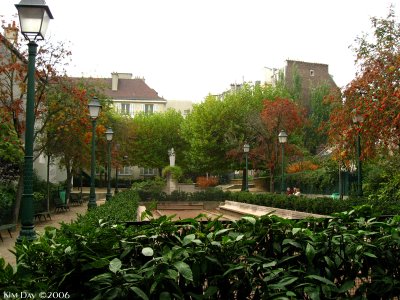 After leaving the cemetery we wandered into a pretty park watched over by a headless statue of St. Denis, the first Bishop Paris. So, the story goes, Bishop Denis was beheaded by the Romans. After his beheading, legend says that Denis picked up his head and walked several kilometres, all the while preaching to his followers, before finally collapsing at the current site of the Abbey of St. Denis. Canonized by the Catholic church, Denis is the patron saint of headaches and stomach problems, celebrated with a feast day on October 9th. The hill of Montmartre takes its name from his and his companions martyrdom ("Mont" refers to the French word for Mountain and "Martre" a Martyr--officially mountain of the martyrs.)
After leaving the cemetery we wandered into a pretty park watched over by a headless statue of St. Denis, the first Bishop Paris. So, the story goes, Bishop Denis was beheaded by the Romans. After his beheading, legend says that Denis picked up his head and walked several kilometres, all the while preaching to his followers, before finally collapsing at the current site of the Abbey of St. Denis. Canonized by the Catholic church, Denis is the patron saint of headaches and stomach problems, celebrated with a feast day on October 9th. The hill of Montmartre takes its name from his and his companions martyrdom ("Mont" refers to the French word for Mountain and "Martre" a Martyr--officially mountain of the martyrs.) 

As we wandered up and down the hill, we visited a number of artists dwellings including that of Van Gogh and Marcel Amyé.

Marcel Amyé is a famous French write who wrote the tale of "The Man Who Could Walk Through Walls" (Le Passe-Muraille). In the book, Dutilleul, a civil servant who worked for the Registry Ministry, discovered that he could walk through walls due to a problem with his thyroid. After a number of adventures, Dutilleul accidentally took some medication prescribed by his doctor to correct the conditions and found himself stuck in a wall after a tryst with a new lover. A statue (of sorts) honors Amyé's character outside Amyé's former home.

 But, before you arrive at the Basilica, you wander through a square of active artists selling their paintings.
But, before you arrive at the Basilica, you wander through a square of active artists selling their paintings. 
07 November 2006
Homeward Bound
I spent my last afternoon in Paris with a walking tour of the Montmartre district, or as our guide called it, the "Stair Master Tour". It could also be titled "tales of artists who either committed suicide or died destitute and alone." Check back in a few days for details after I get home. I also still owe you all my Halloween tale of the Loire Valley. You don't want to miss seeing Princess Foofy Pants in her native habitat (love ya Mia!).
Hopefully, my flight will be uneventful and my luggage will all be within the weight limits and my car service will show up on time (they were late picking me up from the airport).
Catch y'all State-side soon!
05 November 2006
La Tour Eiffel
 My time here in Paris is winding down now. It's hard to believe I've been here almost two weeks now. I've come to feel very at home here. It's such an easy city to navigate and despite the stereotypes, Parisians are very friendly. The great thing about Parisians is that if they're nice to you, you know they really mean it. Parisian's don't get fired for being rude in a store or restaurant. If you complain, they don't care for the most part. They just look at you and shrug with an attitude of "you're just lucky I'm helping you or paying attention to you at all." It's not a particularly customer-service oriented country. In Paris, the customer is rarely, if ever right. So, again, if they are nice to you, it's because they actually like you. In some ways, it's rather refreshing. At home in the US it's a fake niceness often--they have to be nice as part of the job. Truthfully, I prefer the French way. You at least pretty much know where you stand. Aside from one rather snooty hostess at Lênotre, of all places, my experiences really have all been good.
My time here in Paris is winding down now. It's hard to believe I've been here almost two weeks now. I've come to feel very at home here. It's such an easy city to navigate and despite the stereotypes, Parisians are very friendly. The great thing about Parisians is that if they're nice to you, you know they really mean it. Parisian's don't get fired for being rude in a store or restaurant. If you complain, they don't care for the most part. They just look at you and shrug with an attitude of "you're just lucky I'm helping you or paying attention to you at all." It's not a particularly customer-service oriented country. In Paris, the customer is rarely, if ever right. So, again, if they are nice to you, it's because they actually like you. In some ways, it's rather refreshing. At home in the US it's a fake niceness often--they have to be nice as part of the job. Truthfully, I prefer the French way. You at least pretty much know where you stand. Aside from one rather snooty hostess at Lênotre, of all places, my experiences really have all been good.I finally made it to the Eiffel Tower today. I know, that would have be the place most people go first when they get here. But, not me. In my own defense, it's not exactly close to my hotel. It's about as far away on the left bank as you can get from my hotel. I'm staying a neat little hotel called Hôtel Britannique a block from the Seine and the île de la Cité where Notre Dame is located. It's a 39 room hotel that is close to just about everything historic--the Louvre, Les Halles, the Marias, Notre Dame, Ile de St. Louis, the Latin Quarter, St. Germain de Pres--except the Eiffel Tower.
I finally figured out the best way to get there by Metro (Line 1 from the Chatelet stop to the FDR station and then transfer to line 9 down to the Trocedero stop). By arriving from the Trocedero, you really get a great view of the Eiffel Tower as you come through the Jardin du Trocedero across the Pont d'Iena. The first thing you notice is it's massive size. The tower soars into the sky and just dwarfs everything around it. The pictures I've seen before just don't do it justice. This first picture was taken some distance away from the top of Trocodero Plaza across the Seine. It's still about a 5 minute walk to the Tower from here.

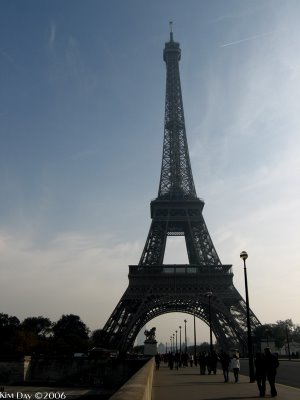
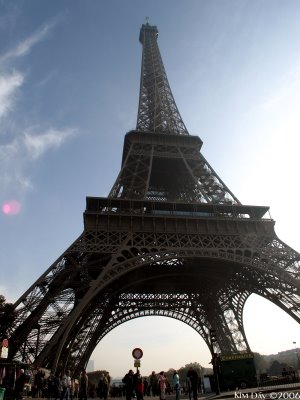


The Eiffel Tower extends 1000 feet into the sky (approximately 92 stories). There are observation platforms at 200 (18 stories), 400 (38 stories) and 900 feet (83 stories). You get to the top through a series of 3 elevators. The higher you go the more you pay--11 euros to take the elevators up to the top platform. Each time you get on an elevator, they tear a corner off your ticket. It is possible to walk to the second platform, but after my experience with the Arc de Triumph, I decided to take the elevator. Fortunately, since it's November the Tower wasn't crowded and it didn't take that long to get into the first Elevator. The elevators are powered by the same hydrolic lifts used in 1889 when the Tower opened (part of which you can see in the picture to the left). As you creep closer to each level, you can feel your ears pop with the increasing elevation. You peer out through the Tower's iron work as the Paris skyline receeds below you.
Fortunately, since it's November the Tower wasn't crowded and it didn't take that long to get into the first Elevator. The elevators are powered by the same hydrolic lifts used in 1889 when the Tower opened (part of which you can see in the picture to the left). As you creep closer to each level, you can feel your ears pop with the increasing elevation. You peer out through the Tower's iron work as the Paris skyline receeds below you.
The first two platforms are are fairly wide with restauarants, gift shops and a post office. These are the best places to get a bird's eye view of some of the cities attractions.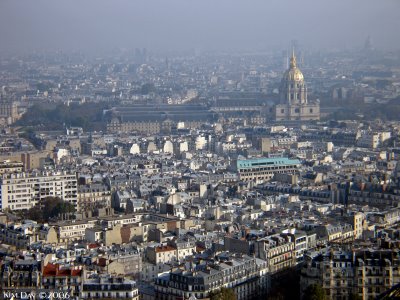
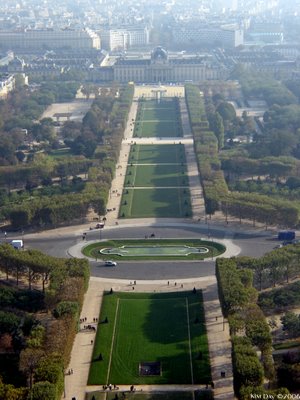
 As you climb to the top platform, the space narrows with the Tower and it can be hard to manoever through all the people. The inside observation deck is ringed with distance markers that show how far it is as the crow flies to places like Reykjavik, Los Angeles and Brazil, etc.
As you climb to the top platform, the space narrows with the Tower and it can be hard to manoever through all the people. The inside observation deck is ringed with distance markers that show how far it is as the crow flies to places like Reykjavik, Los Angeles and Brazil, etc.
The view from the top is spectacular. On a clear day you can see for 80 miles. Even on a hazy day you can see pretty far.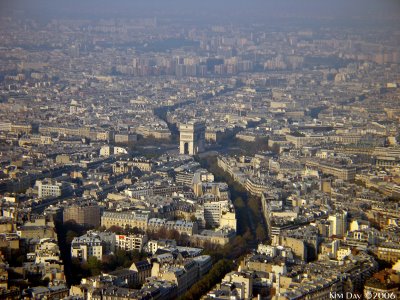 As amazing as this Tower is during the day, it becomes breath taking at sunset and in the dark of night. Around 5:15 the Tower lights start to come on one by one. The sky begins to darken and natures light show takes over.
As amazing as this Tower is during the day, it becomes breath taking at sunset and in the dark of night. Around 5:15 the Tower lights start to come on one by one. The sky begins to darken and natures light show takes over.







Then, at 6:00 pm, the Eiffel Tower starts to sparkle. The dancing lights continue for 10 minutes until fading away until the next show at 7:00 pm. The sparkling lights have been the exclamation point at the Eiffel Tower since the millenium celebration six years ago.
By 6:30 night has complete taken over and the brightly lit Tower can be seen for miles around Paris.




04 November 2006
Braving the French Patisserie Class
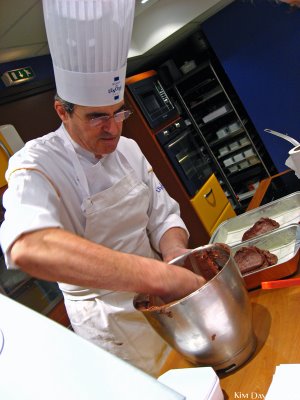 Well, I'm happy to report that no international incidents were caused today (at least not by me). I survived my French cooking class and had a blast (even though I only understood about half the French). I started by treating myself lunch at Lênotre and it was well worth it. Finally, it was time to go downstairs for my class.
Well, I'm happy to report that no international incidents were caused today (at least not by me). I survived my French cooking class and had a blast (even though I only understood about half the French). I started by treating myself lunch at Lênotre and it was well worth it. Finally, it was time to go downstairs for my class.We were to prepare 4 dishes over the course of our 3 1/2 hour class: A chocolate orange sorbet, chocolate tarts, individual chocolate cakes with a molten chocolate centers with raspberry puree and the French version of chocolate brownies. I learned the proper way to chop up blocks of chocolate, to whisk just about anything, how to weight the proper amount of ingredients in the metric system (for example rather than the recipe calling for just 2 eggs, they tell you how many grams of eggs to use) and the fine art of using a pastry bag to make those melting chocolate cakes.
Below, is a picture of cherry pits that are used to weight the pastry down and keep it from puffing up while cooking. The other American in the class says she uses dried kidney beans for this same purpose. Just make sure you use a paper liner between the pastry dough and your chosen weight.
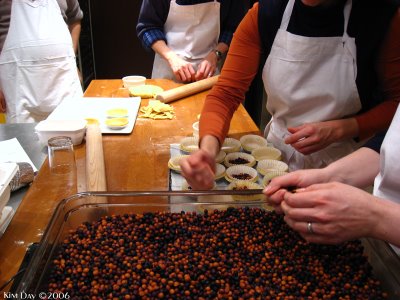

Preparing the cake cups for the batter

Prepared cake cup with butter and almonds

Some of the finished product:
Brownies

Chocolate Tartes

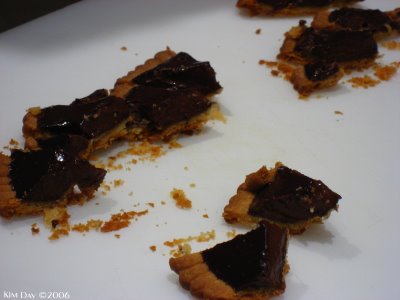
Molten Chocolate Cake with Raspberry Purée

Chocolate Orange Sorbet

Nymphéas and steps, oh my!
 This morning I wandered out into the outer arrondisements to visit the Musée Marmottan, a museum devoted primarily to Claude Monet. I'd been on the fence about going, because it's way out of the way and kind of a pain to get to, but this morning I finally dug out my Métro map and figured out how to get out there. I'm so glad I made the effort. I got to sit in a room for nearly an hour surrounded by nearly 20 of Claude Monet's water Lily paintings. It was so spectacular, I almost couldn't make myself leave. Sitting among those pictures was incredibly peaceful and a feast for the eyes. Photos simply do not do any of those masterpieces justice. By the way, I stole the above photo from AllPosters.com since pictures were not allowed in the museum. So, if you're a Monet lover, drop by their site and check out their huge collection of Monet posters and prints.
This morning I wandered out into the outer arrondisements to visit the Musée Marmottan, a museum devoted primarily to Claude Monet. I'd been on the fence about going, because it's way out of the way and kind of a pain to get to, but this morning I finally dug out my Métro map and figured out how to get out there. I'm so glad I made the effort. I got to sit in a room for nearly an hour surrounded by nearly 20 of Claude Monet's water Lily paintings. It was so spectacular, I almost couldn't make myself leave. Sitting among those pictures was incredibly peaceful and a feast for the eyes. Photos simply do not do any of those masterpieces justice. By the way, I stole the above photo from AllPosters.com since pictures were not allowed in the museum. So, if you're a Monet lover, drop by their site and check out their huge collection of Monet posters and prints. 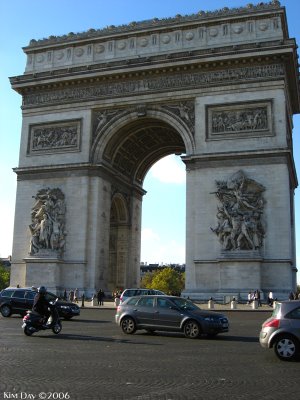 After my commune with Monet, I hopped back on the Metro and headed up to the Arc de Triumph. The Arc was built to commemorate Napoleon's' 1805 victory at the battle of Austerlitz. However, it took 20 years to complete and opened in 1926, partially due to Napoleon's ouster from power. Napoleons funeral procession passed underneath it only four years later on the way his final resting place at the Invalides.
After my commune with Monet, I hopped back on the Metro and headed up to the Arc de Triumph. The Arc was built to commemorate Napoleon's' 1805 victory at the battle of Austerlitz. However, it took 20 years to complete and opened in 1926, partially due to Napoleon's ouster from power. Napoleons funeral procession passed underneath it only four years later on the way his final resting place at the Invalides.The Arc de Triumph has to be surrounded by one of the worlds biggest traffic circles. It's so congested they don't even all pedestrians to cross it. You have to go down a flight of stairs to the tunnels that go underneath the circle and then back up another flight of stairs in the center of the circle. Cars and motorcycles whiz around it like maniacs.
 What 15 stories of spiral staircases look like from the top!
What 15 stories of spiral staircases look like from the top!Huffing, the cool air washes over you before you take a step up to the observation platform. The city sprawls before you. Ten avenues converge at the Arc, with the widest and longest being the famous Champs-Elysée, stretching from the Place de la Concorde to La Defense (another more modern Arc). In the picture below, you can see all the way to the Louvre and beyond.

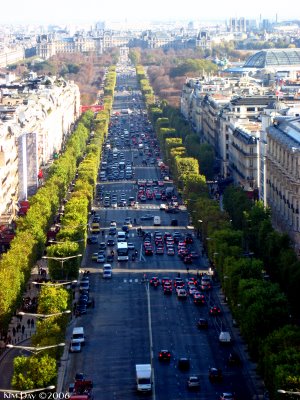

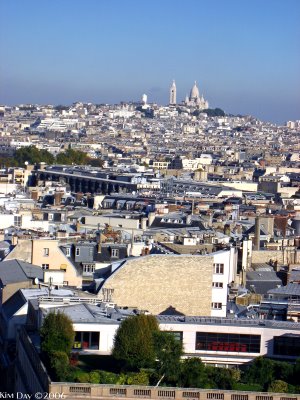 The other end of the Champs Elysée.
The other end of the Champs Elysée.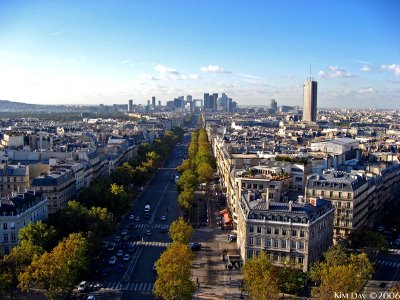
After my climb back down from the top of the Arch de Triumph, I decided to do a little shopping. I headed down the Champs Elysée and risked life and limb to cross the wide Avenue to a post office to mail a handful of post cards. Then, I wandered into the Virgin Megastore to pick up a copy of the UK version of Switch and some Depeche Mode Maxi Cds that aren't available in the US.
I ended my afternoon with stop at Angelina's tea room on the Rue de Rivoli (near the Meurice Hotel). Angelina's Chocolate Chaud (hot chocolate) is legendary. It is served in a small pitcher with a small bowl of very thick, sweet vanilla whipped cream. Every guide I've spoken to during this trip has said that this is a stop you have to make. I waited about 20 minutes in line for the table and it was worth the wait. The Chocolate Chaud is so thick you almost need a fork to stir it. Unlike the hot chocolate you get in the States, this is not sicky sweet; instead it's made from dark chocolate that is slightly bitter (if I had to guess dark chocolate that is about 85%). Before drinking, you drop a large dollop of thick whipped cream into the steaming chocolate and wait for it to melt slightly.
Then, it's time to drink this chocolate decadence. The texture is like chocolate velvet as it slides across your tongue. The slight bitterness is accented by the sweet fluffy cream. In between sips, you cleanse your palate with a bite of one of Angelina's pastries (in my case a strawberry tarte) and a sip of water.
On a side note, the place was loaded with Parisian pregnant women. Apparently, les enfants-to-be love the hot chocolate too.
After dinner at my new favorite bistro around the corner of my hotel, I wandered down to the Quai de Megisserie to watch the Eiffel Tower sparkle like a Christmas tree. Every evening at Sunset, the Eiffel Tower sparkles for 10 minutes from the top of the hour until 10 minutes afterwards. It's really quite the site; check out the video below:
Tomorrow, I brave the world of French cooking classes at the famous École Lênotre. Lênotre operates one of the top cooking schools. I'll be in the amateur division and hopefully not causing an international incident by burning the place down due to my lack of comprehension of oral French.



